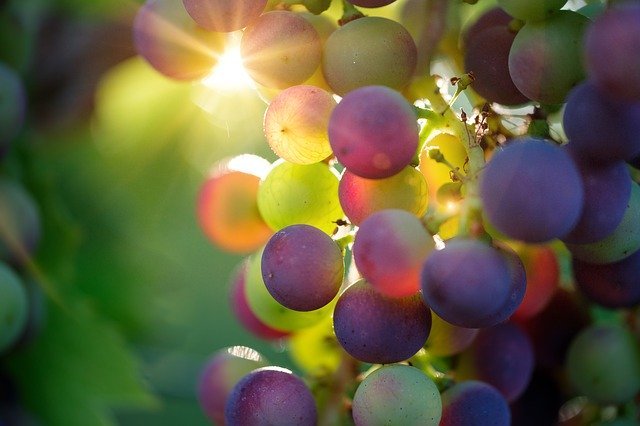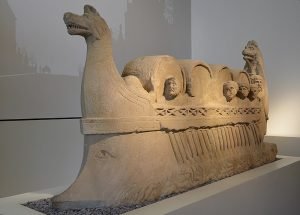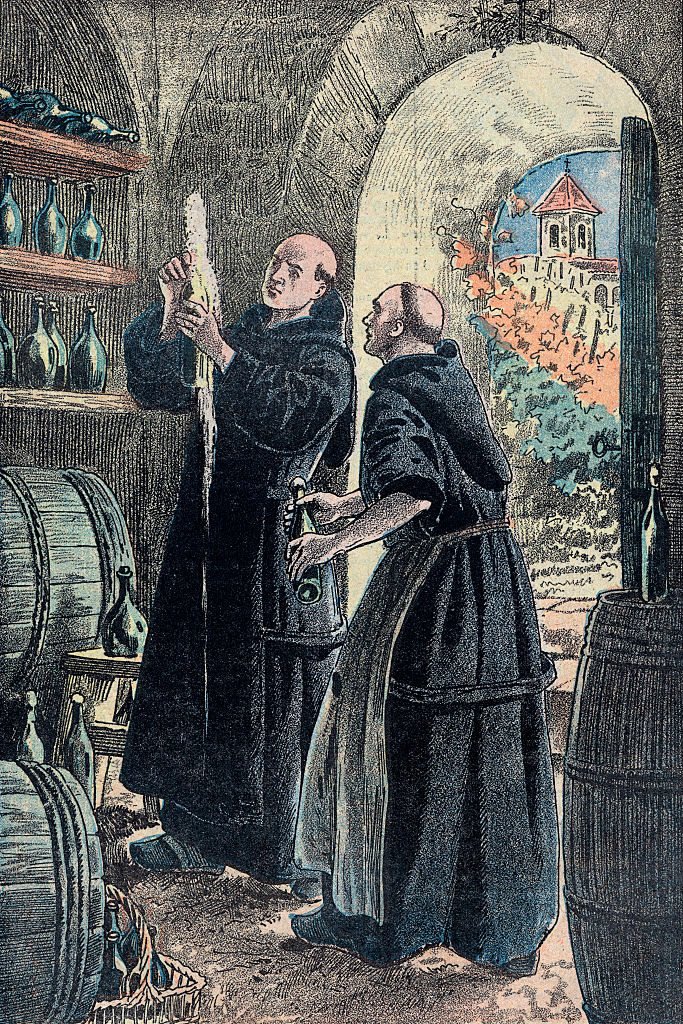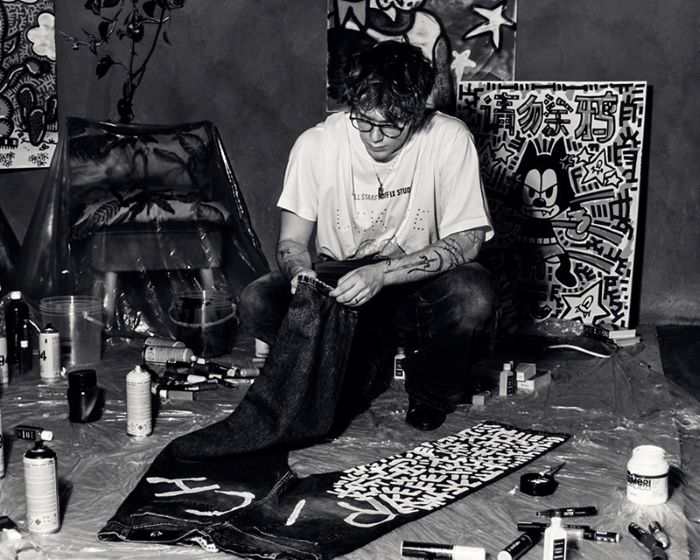Drinkable Stars

Per Aspera Ad Astra : A Four Part Series on the Various Bubblies of the World
Part I : The Big Bang
In the modern wine world bubbles are synonymous with celebration but, historically, it was a problem. The transport of wine was essential before the Romans spread the vine throughout modern day Europe. How do you stop liquid from spilling out of the amphorae (20-40 liters), tun (950–960 liters), or massive dolia (no standard, but up to 9000 liters) during transport? A stopper of course! This was especially essential when a merchant ship hit rough waters. The most famous stopper today, cork, had a variety of uses dating as far back as 3000 B.C.E. However, it was not efficiently applied to the wine world until the mid-17th century. Plant resin, tree resin, olive oil, oil-soaked rags, and clay lids were used by our ancestral wineholics.
I am going to assume you know that it takes fermentation of grapes to make wine. That is, the complete consumption of the grape’s natural sugars by the yeast that live on said berries. If you don’t completely understand that process, don’t worry, winemakers of antiquity didn’t either. This created wine that was both strong and unpalatable. This is why sea-water, honey, and various spices were commonly added. When the fermentation appeared to stop, the alcoholic liquid would then be sold and transported throughout the known world. Complete with the sediment. Being a living organism, the yeast could either be dead or alive at this point.
The unfiltered, unfined wine consisting of dead yeast cells (lees, or lies in French) would break down. This releases all sorts of compounds that get absorbed by the wine. As long as you can control the interaction, it will create complexity, palate weight, and texture in a wine. The ancients tried to control it to the best of their limited knowledge but success was rare. A self-destruction, or autolysis, occurs when the yeast cells eat their own enzymes. If autolysis was sparked then it reduced astringency, and created a creamy mouthfeel. It also could morph into unique flavors of bread and nuts. Doesn’t sound too bad to me!
But there is also the possibility that the yeast doesn’t die and, instead, hibernates when it gets too cold. It wakes in two instances: the rise of temperature (usually in spring), or the frantic movement of rough waters (agitation). I don’t know about you but when I wake up, I’m pretty hungry. Being a living organism, yeast wakes up to eat the sugars present, creating a secondary fermentation. A stopper on top of the vessel prevented its liquid byproduct (alcohol) from spilling. The other byproduct (carbon dioxide) floats upwards. Since it is trapped, it creates pressure and bubbles. Back then, more of a slight fizz, but that was not appreciated like it is today.

Transportation of wine barrels on the Moselle River. The barge is loaded with four large wine barrels. Circa 220, B.C.E.
Wooden barrels have been used since the days of Ancient Mesopotamia. The oak barrel was introduced to the known world when the Romans conquered Gaul, who used it to transport beer. In the 2nd Century A.C.E. the oak barrel became the main mode of production, storage, and transport for wine and various other products. The Romans also noticed that wine lasted longer in oak barrels, sometimes even tasting better as a result. This made it easier to sell.
Competition Fuels Innovation (Sort Of)
With the fall of the Roman Empire, we can thank monks for keeping wine and beer culture alive. Wine was used for the sacrament. All excess was sold to the public but was not as popular as ale or mead. It was the monks of France that did all they could to improve flavor and quality in wine. For competition’s sake, the Cluniac Order in the Burgundy area developed a new way to the art of winemaking. These monks improved methods in pruning, varietal selection, and wine preservation.
(As a wine nerd, I geek out on this next part)
More importantly, they gave birth to the idea of selecting a site based on the nature of the local soil and climate. Even to this day, this is locally known as Climats. The vines of certain Climats needed protection from being eaten by animals so the monks closed, clos in French, the areas with walls. This is the earliest notion of what we call terroir! As quality improved, the explosion of pressurized wine simultaneously became a more prominent problem as harsh bubbles were not appreciated. In fact, they were loathed throughout Europe. With barrels being watertight, imagine how many times someone would check on the product just to have it explode in their face. Not fun!
 The monks in the Champagne region could not compete with their Burgundian counterparts. Both regions grew the same varietals but have different elevation, different temperate climate, and different soil. Burgundian wine became quite sought after when the Dukes of Burgundy banned the import and export of non-Burgundian wines in the 14th Century. We can surmise that this paved the way for all other wines to reach far away markets. The Champenois monks did their best to create a consistently still product that could replicate the Burgundian style. It was the transport and subsequent spring heat that kept them from achieving that goal due to spontaneous secondary fermentation! The local monks did everything in their power to get rid of those pesky bubbles. Yet, the Brits demanded more and more of it. Unbeknownst to the monks, Brits were acquiring a taste for the accidental bubbly from the Champagne area of France!
The monks in the Champagne region could not compete with their Burgundian counterparts. Both regions grew the same varietals but have different elevation, different temperate climate, and different soil. Burgundian wine became quite sought after when the Dukes of Burgundy banned the import and export of non-Burgundian wines in the 14th Century. We can surmise that this paved the way for all other wines to reach far away markets. The Champenois monks did their best to create a consistently still product that could replicate the Burgundian style. It was the transport and subsequent spring heat that kept them from achieving that goal due to spontaneous secondary fermentation! The local monks did everything in their power to get rid of those pesky bubbles. Yet, the Brits demanded more and more of it. Unbeknownst to the monks, Brits were acquiring a taste for the accidental bubbly from the Champagne area of France!
Glass bottles were inconsistent so, for centuries, it was illegal to sell wine in glass bottles. In the early 1600s glass bottles became more possible with the advent of the coal furnace. It allowed for thicker, more difficult-to-break glass. This was groundbreaking. With this innovation came the use of the cork as we know it today, with beer drinkers leading that trend. By the 1650s corked bottles were more available, allowing the monks to experiment ridding their Champagne product of the bubbles. Simultaneously, carbonated beer resulting from accidental secondary fermentation, was gaining traction in popularity. It is no wonder that this bubbly from Champagne became sought after in England!
A Star Is Born

A young Dom Pérignon being disappointed by the eruption from bubbles.
In 1668, the Benedictine Abbey at Hautvillers had appointed a very detail oriented Dom Pierre Pérignon as cellar master. You may have heard that this blind monk discovered, or invented, sparkling wine, and exclaimed, “I am tasting the stars”! The opposite is true. He was not blind and he did all he could to prevent the secondary fermentation from occurring. Oh, and I’d safely bet that he didn’t say that.
What Dom Pérignon did do is create some of our modern techniques for high quality wine. He began to harvest early in the morning, reject bruised or broken berries, press quickly and up to five times. Dom Pérignon was a firm believer that Pinot Noir was superior to all grapes. Yet he blended it with other varieties, including the local white, to produce a softer wine than was the norm. He knew that the skin of the grapes produce rough textures and harsher flavoring. The first pressing produced a white wine. The last pressing was a darker color that would not be used at all.
All together these are the precursors to what we call the Méthode Champenoise, or Champagne Method. Pérignon’s focus eventually reversed and he went on to develop ways to increase carbonation. However, this sparkling wine didn’t become the product it is today until the early 1800s. That happened when a new technique in the bottling process was “invented” by a widow on the brink of bankruptcy. But I’ll save that story for our next article.
I’m pretty excited for this mini-series on bubbly! The second part will start where we left off. I will talk about what goes into making Champagne, some of its most important historical protagonists, and the science that goes into making the stars sparkly bubbles. The second part I will talk about other sparkling wines in Europe that compare and are great alternatives. The fourth part will be about Prosecco and other Italian bubblies. I’ll even squeeze in understanding how to choose what is best for various situations.






